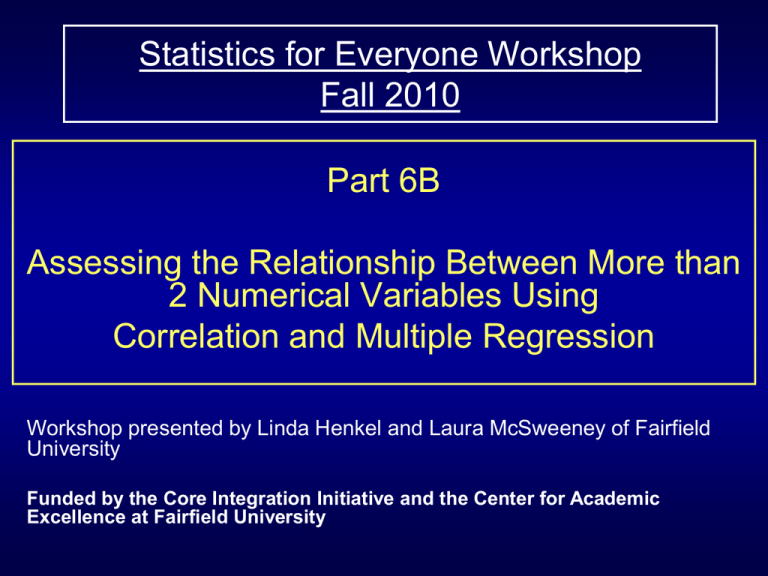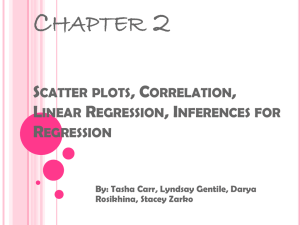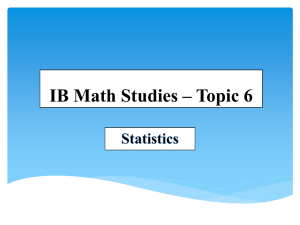Assessing the Relationship Between More than 2
advertisement

Statistics for Everyone Workshop Fall 2010 Part 6B Assessing the Relationship Between More than 2 Numerical Variables Using Correlation and Multiple Regression Workshop presented by Linda Henkel and Laura McSweeney of Fairfield University Funded by the Core Integration Initiative and the Center for Academic Excellence at Fairfield University Assessing the Relationship Between 3+ Numerical Variables With Correlation What if the research question we want to ask is whether or how strongly 3 or more variables are related to each other, but we do not have experimental control over those variables and we rely on already existing conditions? • TV viewing, exercise, and obesity • Age, body temperature, and severity of flu symptoms • Tire pressure, number of days since last oil change, and gas mileage • Volume, R-rating, and compression of insulation Assessing the Relationship Between 3+ Variables With Correlation The nature of the research question is about the association between the variables, not about whether one or some causes the other Correlation describes and quantifies the systematic, linear relation between variables Correlation Causation Statistics as a Tool in Scientific Research Types of Research Question • Is there an association between X1, X2, …, Xk and Y? • As the X’s change, what does Y do? • How well can we predict Y from X1, X2, …, Xk? Terminology X variables: predictors (independent variables, explanatory variables, what we know) Y variable: criterion (dependent variable, response variable, what we want to predict) Example: Is there a relationship between diastolic blood pressure (DBP) and the birth weights (BW) and age of newborns? Y = Diastolic Blood Pressure (mm Hg) X1= Birth Weight (oz), X2 = Age (days) Types of Correlation Pairwise (or Bivariate) Correlation: Correlation between 2 variables measures the strength of the linear relationship between the 2 variables Multiple Correlation: Correlation between Y and variables X1, X2, …, Xk = sqrt(R2) [Though, people usually just report R2 instead of multiple correlation] Partial Correlation: Measure of association between Y and Xj controlling for effects of the other X’s What about R2? Often in correlational research the value R2 is reported. R2 = Proportion of variability of Y accounted for by all the X’s and the linear model But R2 increases as the number of X variables increase Adjusted R2 = 1 (1 R2)(n 1)/(n k 1) Takes the number of variables into account Pairwise (or Bivariate) Correlation Correlation between: BW and Age, BW and DBP, Age and DBP Pairwise Correlation BW Age DBP BW 1 Age .107 DBP .441 1 .871* 1 *significant correlation (p <.001) Multiple Correlation Correlation between DBP and both BW and Age R R Square Adjusted R Square .939* .881 .863 *significant correlation (p <.001) Partial Correlation Correlation between: DBP and BW after correcting for Age DBP and Age after correcting for BW Partial Correlation SBP BW Age .713* .923* *significant correlation (p <.001) Multiple Linear Regression Assumed underlying model Y = + 1X1 + 2X2 + …+ kXk + where is normally distributed with mean 0 and variance 2 X1, X2, …, Xk: Independent Variables Y: Dependent Variable Each i, i = 1, 2, …, k, represents the partialregression coefficient or the average increase in Y per unit increase in Xi adjusted for all the other variables in the model (or holding all the other variables constant). Estimated by the value bi. Estimating the Regression Model Y’ = a + b1X1 + b2X2 + …+ bkXk Y’ = Predicted Y-value Example: Is there a relationship between diastolic blood pressure (DBP) and the birth weights (BW) and age of newborns? Y’ = Predicted DBP(mm Hg) X1= BW (oz), X2 = Age (days) Least Squares Line Error or residual = observed Y – predicted Y = Y – Y’ The least-squares line is the “best fit” linear model that minimizes the sum of the square errors/residuals i.e: The estimates a, b1, b2, …, bk minimize 2 Y Y' The Multiple Regression Model Y’ = a + b1X1 + b2X2 + …+ bkXk Ex: Is there a relationship between diastolic blood pressure and the birth weights and age of newborns? Y’ = Predicted DBP(mm Hg) X1= BW (oz), X2 = Age (days) Y’ = 23.45 + 0.126X1 + 5.89X2 So, on average, newborns’ DBP increases by 5.89 mm Hg for each additional day in age (assuming BW were fixed). Hypothesis Testing For Multiple Linear Regression The F test allows a scientist to determine whether their research hypothesis is supported Step 1: Overall F-Test for Model Significance Test whether the linear model is significant. Step 2: Stepwise tests (or t-tests for Partial Regression Coefficients) Determine which independent variables are significant in the model. Remove any independent variable that is not significant. Step 1: Overall F-Test For Multiple Linear Regression Y = + 1X1 + 2X2 + …+ kXk + where is normally distributed with mean 0 and variance 2 Null hypothesis H0: • There is not a linear relationship between X1, X2, …, Xk and Y • 1 = 2 = k = 0 Overall F-test for Multiple Regression Research hypothesis HA: • At least one Xi is linearly related to Y • At least one i 0 Teaching tip: 1.) Very important for students to be able to understand and state the research question so that they see that statistics is a tool to answer that question 2.) If the multiple linear regression model is significant, then you must determine whether each independent variable is significant. Sources of Variance in Multiple Linear Regression SSTotal = SSRegression + SSResidual (Yi – MY)2 = (Yi’ – MY)2 + (Yi – Yi’)2 How much do all the individual scores differ from the grand mean How much do all the predicted values differ from the grand mean How much do the individual scores differ from the predicted values Total Sums of Squares Regression Sums Residual Sums of Squares of Squares Each F test has certain values for degrees of freedom (df), which is based on the sample size (N) and number of conditions, and the F value will be associated with a particular p value SPSS calculates these numbers Summary Table for Multiple Linear Regression: X1, X2, .., Xk and Y Source Sum of Squares (SS) df Mean Square (MS) Regression (Yi’ – MY)2 k SSRegression dfRegression Residual (Error) (Yi – Yi’)2 N – k -1 SSResidual dfResidual Total (Yi – MY)2 N-1 F MSRegression MSResidual N= # samples To report, use the format: F(dfRegression, dfResidual) = x.xx, p _____. The F-Test • A test for multiple regression gives you an F ratio • The bigger the F value, the less likely the relationship between the Xs and Y is just due to chance • The bigger the F value, the more likely the relationship between the Xs and Y is not just due to chance and is due to a real relationship The F-Test • So big values of F will be associated with small p values that indicate the linear relationship is significant (p < .05) • Little values of F (i.e., close to 1) will be associated with larger p values that indicate the linear relationship is not significant (p > .05) • Based on p value, determine whether you have evidence to conclude the relationship was probably real or was probably due to chance: Is the research hypothesis supported? What Do We Mean by “Just Due to Chance”? p value = probability of results being due to chance When the p value is high (p > .05), the obtained relationship is probably due to chance .99 .75 .55 .25 .15 .10 .07 When the p value is low (p < .05), the obtained relationship is probably NOT due to chance and more likely reflects a real linear relationship .04 .03 .02 .01 .001 What Do We Mean by “Just Due to Chance”? In science, a p value of .05 is a conventionally accepted cutoff point for saying when a result is more likely due to chance or more likely due to a real effect Not significant = the obtained relationship is probably due to chance; there doesn’t appear to be a linear relationship between Y and the X’s; p > .05 Statistically significant = the obtained relationship is probably NOT due to chance and is likely a real linear relationship between Y and at least one of the Xi; p < .05 Interpreting the F test for Multiple Regression Cardinal rule: Scientists do not say “prove”! Conclusions are based on probability (likely due to chance, likely a real effect…). Be explicit about this to your students. Based on p value, determine whether you have evidence to conclude the relationship was probably real or was probably due to chance: Is the research hypothesis supported? p < .05: Significant • Reject null hypothesis and support research hypothesis (the relationship was probably real; X’s are linearly related to Y) p > .05: Not significant • Retain null hypothesis and reject research hypothesis (any relationship was probably due to chance; Xs are not linearly related to Y) More Teaching Tips You can ask your students to report either: • the exact p value (p = .03, p = .45) • the cutoff: say either p < .05 (significant) or p > .05 (not significant) You should specify which style you expect. Ambiguity confuses them! Tell students they can only use the word “significant” only when they mean it (i.e., the probability the results are due to chance is less than 5%) and to not use it with adjectives (i.e., they often mistakenly think one test can be “more significant” or “less significant” than another). Emphasize that “significant” is a cutoff that is either met or not met -- Just like you are either found guilty or not guilty, pregnant or not pregnant. There are no gradients. Lower p values = less likelihood results are due to chance, not “more significant” Next Steps If the overall model is not significant, you stop the regression analysis with this set of variables. There is nothing more to do. If the overall model is significant, the significance of the independent contributions of each explanatory variable is tested. Just because the model is significant does not mean that every variable is. Step 2: Stepwise Test For Multiple Linear Regression You test only one variable at a time to see if it is significant or not, assuming the other variables are in the model There are various ways to do this (Standard, Forward Selection, Backward Selection, Stepwise, Hierarchical). The order in which you enter in the data may make a difference. Null hypothesis H0: i = 0 while all other J 0 Research hypothesis HA: i 0 while all other J 0 Step 2: Stepwise Test For Multiple Linear Regression The test statistic is: t = bi/SE(bi) Where: the partial-regression coefficient bi is the estimate for i from the regression model and SE(bi) is the standard error of the partialregression coefficient The Essence of a T Test Each t test gives you a t score, which can be positive or negative; It’s the absolute value that matters The bigger the |t| score, the less likely that the slope of Xi being different from 0 is just due to chance The bigger the |t| score, the more likely that Xi is linearly related to Y So big values of |t| will be associated with small p values that indicate that there is a significant relationship between Xi and Y (p < .05) Little values of |t| (i.e., close to 0) will be associated with larger p values that indicate that the relationship between Xi and Y is not significant (p > .05) Next Steps If the null hypothesis is not rejected (p >.05), then you can remove the variable Xi from the model. You would rerun the stepwise test without Xi and see if another variable could be removed. You would continue this process until no more variables can be removed. If the null hypothesis is rejected (p < .05) then you do not remove the variable Xi from the model. Running Multiple Linear Regression in SPSS Multiple Linear Regression: When you want to predict a numerical variable Y from numerical variables X1, X2, …, Xk Need: Enter X1, X2, …, Xk and Y data in SPSS To get linear model: Analyze Regression Linear Move the Y variable to Dependent and the X1, X2, …, Xk variables to Independent; Click Ok. Output: Linear model and output needed to run overall F-test and stepwise tests Reporting the Results of the F Test for Multiple Linear Regression Step 1: Write a sentence that clearly indicates what statistical analysis you used An F test was used to determine if there was a linear relationship between [X1, X2, …, Xk] and [Y]. Or, an F test was used to determine if [X1, X2, …, Xk] is linearly related to [Y]. An F test was used to determine if age and birth weight are linearly related to diastolic blood pressure. Reporting the Results of the F Test for Multiple Regression Step 2: Report whether the overall linear model was significant or not The linear relationship between [X1, X2, …, Xk] and [Y] was significant [or not significant], F(dfRegression, dfResidual) = X.XX [fill in F], p = xxxx. The linear relationship between diastolic blood pressure and birth weight and age was significant, F(2, 13) = 48.08, p < .001. Reporting the Results of the F Test for Multiple Regression Step 3: If the overall model is significant, report whether any of the variables were be removed during the stepwise tests or report that no variable can be removed. Variable [Xi] was not significantly related to Y after adjusting for the other variables [X1, X2, …, Xk] and was removed from the model. t(df) = X.XX, p = X.XX. Or state that all the X variables were significant. The linear relationship between diastolic blood pressure and birth weight and age was significant, F(2, 13) = 48.081, p < .001. Both variables were significant in the model. Cautions Involved in Multiple Linear Regression • Multicollinearity (or independent variables are highly correlated); You may get a model that is significant, but none of the individual variables are or you may get unstable coefficients • Outliers • Too many independent variables • Small samples sizes (need at least 10 samples per variable in model) Assumptions Involved in Multiple Linear Regression • • • • Independence of Independent Variables Linearity Randomness and Normality Homoscedasticity Check the Independence of Independent Variables Check the pairwise correlations or make scatterplots of each pair of variables to see if there is multicollinearity If two variables are highly correlated you may only need to use one of them in your model Variance Inflation Factor (VIF) Test: If VIF > 5 or 10 this indicates multiple collinearity Assessing Randomness and Normality of Residuals Are the residuals random and normally distributed? Make a histogram of the residuals (or standardized residuals which are centered about 0). Assessing Linearity Method 1: Plot Y vs. Xi to see if there is a linear relationship between Y and Xi. [Partial Plot in SPSS] Repeat for all Xs. Method 2: Plot the standardized residuals vs. each Xi and check that the residuals are randomly scattered about the line y = 0; Any pattern would indicate a non-linear relationship between Y and that particular Xi. Assessing Homoscedasticity Homoscedasticity = the variability or scatter of points about the best fit line is fairly constant Method 1: Plot Y vs. Xi [the Partial Plots in SPSS] and see if the fit of the line is fairly constant for all values of Xi. Repeat for all Xs. Method 2: Plot standardized residuals vs. Xi and check that the spread of the residuals is fairly constant for all values of Xi Using Dummy Variables In the Model Dummy variables are used to code in categorical variables into the model If the categorical variable has n subcategories, then you will need n -1 “dummy” variables to describe the categories Ex: Gender (Male = 0, Female = 1) Dummy Variables Ex: Marital Status Responses: Single = 1, Married = 2, Divorced = 3 So, 3 subcategories require 2 dummy variables, X1 and X2 which would be used in the regression model Response X1 (Vector 1) X2 (Vector 2) Single (or Control) 0 0 Married 1 0 Divorced 0 1 Time to Practice Multiple Regression







